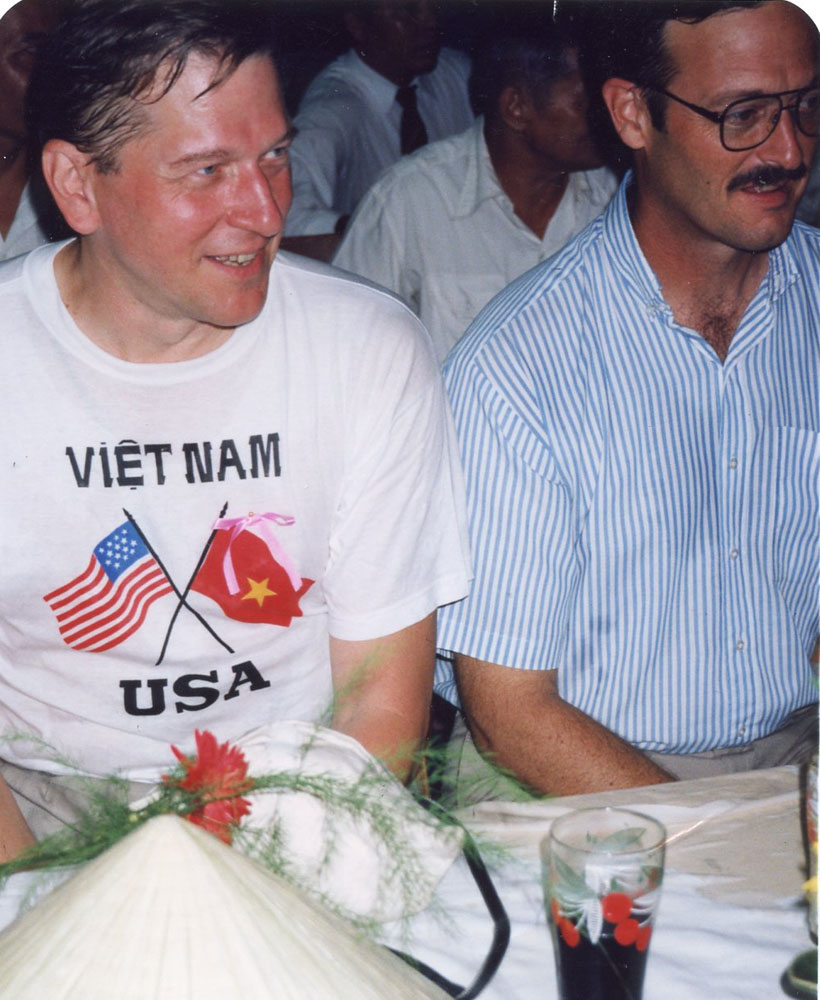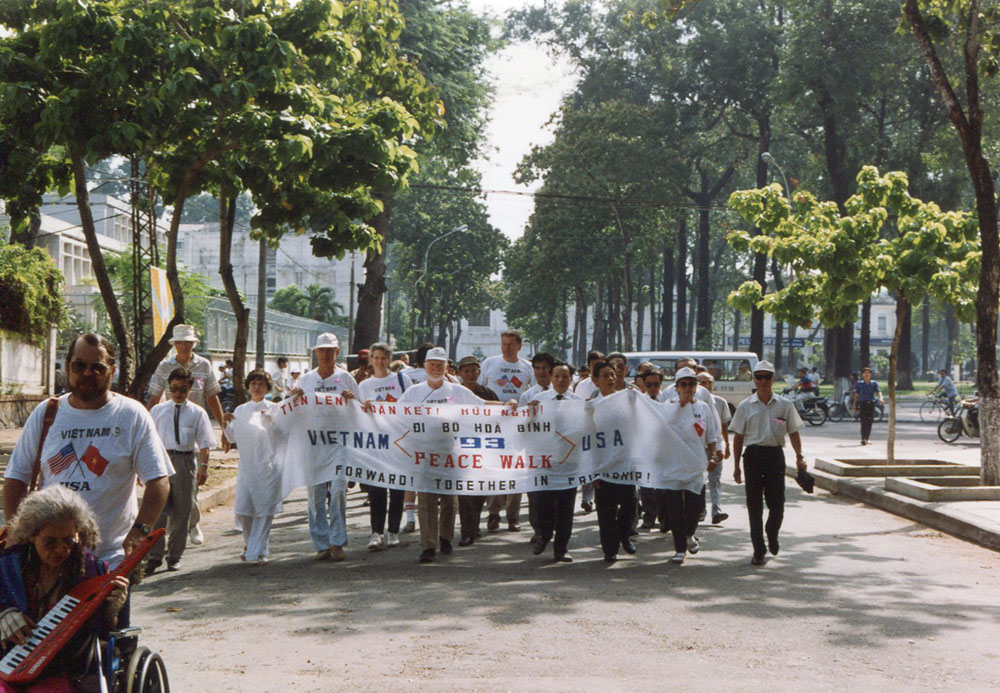 |
Peace Marching in Vietnam 1993By Stephen SossamanAs eager as I was to leave Vietnam and the US Army artillery five decades ago, I later was as eager to return on a more peaceful mission. I did not want my most recent interaction with the people of Vietnam to be the distortions of war. I returned to Vietnam in July 1993 with 11 others, including three other veterans, to conduct walks in five Vietnamese cities to call publicly for an end to the American embargo against normal relations with Vietnam. Our travel to Vietnam was still technically illegal, but the sanctions would end the next year. My personal purpose was to interact with Vietnamese people as humans should interact, peacefully and cooperatively. Only after I left the army did I begin to discover the rich history and complex culture of Vietnam. The army never taught me or my stateside unit to dehumanize Vietnamese, and my unit in Vietnam in effect thought of Vietnamese as in one of three groups: targets, unreliable allies, or nuisance civilians. A couple of other veterans had warned me against returning because they worried that returning might trigger flashbacks or panic attacks. At that time I sometimes felt hyper alert walking in New England woods, alert to likely ambush sites, despite having been an artilleryman rather than an infantryman. But I had no worries about returning. And there was no problem. The Vietnamese I encountered helped me feel exhilarated and secure walking Vietnamese streets. I felt comfortable even in Hanoi, which to me was once mysterious and menacing, and in the once lethal streets around Hue's Imperial Palace. The almost total absence of armed police and soldiers helped. Among pedestrians I saw smiles and looks of indifference, but no frowns or expressions of hostility. In Saigon I spoke with two veterans of our former South Vietnamese allies, who used me to practice their English, swap war stories, and complain mildly about life under the Communists. America's large wartime peace movement, especially veterans organizations like Vietnam Veterans Against the War, can probably be credited for much of Vietnam's friendliness during my return. During the war, the government in Hanoi repeatedly told the population that the American government was run by warmongers but that the average American was friendly and peace loving. They had photos of peace marches to prove it. That reminder that the people of an enemy country are OK likely makes for easier post-war normalization, I think, than we are likely to experience in Iraq or Afghanistan. Three incidents in particular convinced me that the Vietnamese were psychologically recovering from the war better than most Americans were. They had the can-do optimism that used to be part of the American myth, and I hope that they still have it. Vietnamese children lightened my memory load at Hanoi's Army Museum. I was alone, taking an occasional picture, when one large group of schoolchildren turned toward me, away from their teacher, who was showing them rusting fragments of downed American and French aircraft. The children held their poses, and I took the picture. When the photo was developed and enlarged, I saw their smiles and the ease with which they temporarily abandoned a lesson about foreigners' roles in their elders' sacrifices. Those children showed an openness and curiosity that pleased me greatly. I wrote about being an unwitting exhibit in this haiku:
Army Museum: One night in Hanoi three of the veterans in our group were cycle-pedaled through the chaotic traffic of full energy pedestrians and cyclists, to visit with a local entrepreneur. He was eager for contacts in America who knew millionaires who could finance his idea: build a hotel catering to returning American veterans, staffed entirely by former NVA and NLF veterans. I thought that was a doomed idea, but I admired his optimism and his assumption that the fundamental relationship of two nations is trade and tourism, not war. No grudges, just a sort of international brotherhood. Other Vietnamese I met were also obviously eager to rejoin the world community, see the economy flourish, and forget about the war. In two local bookstores, the crowds were after books about learning foreign languages, especially English, of course, the only language with which they could communicate with other Asians and the world at large. At that time, Vietnamese school children were assigned to schools that taught either Russian or English, not both, and that assignment was apparently thought of as a lottery with big winners and big losers. At a cafe in Hue, I experienced the classic one-on-one meeting over beer with a former enemy. He was Le Huy, whose former AO was outside Hue, while mine was in the Mekong Delta. I have lost the photo, but certainly not the memory. Our conversation was fragmented and halting, but sincere and open, so it felt right for the next stage of relations between the people of Vietnam and the United States. In a cemetery for NLF fighters killed in action in Cu Chi, I walked among the grave markers, wondering about the lives and deaths of the NLF soldiers buried there. Many of the markers lacked such basic information as the date or province of the soldier's birth. I found myself in front of the grave of a man killed in 1968, when I was in Vietnam. I stepped back, and was about to take a picture of this grave when a child's face appeared in my camera lens, out of focus but patient. Young Vietnam was gently bringing me back to the present. I took her picture, and pictures of her two friends, and was in a far better mood when, in the next hour, we visited part of the harrowing tunnel system in which thousands of Vietnamese lived and suffered to avoid American firepower. Vietnam today has its troubles, like every other country, but my hope is that Vietnam's historic courage, optimism, and ingenuity will bring them the prosperity and accomplishment that I saw them planning for in 1993. Stephen Sossaman was a 9th Infantry Division artillery fire direction computer. An emeritus professor at English at Westfield State University in Massachusetts, living in Burbank.
|



